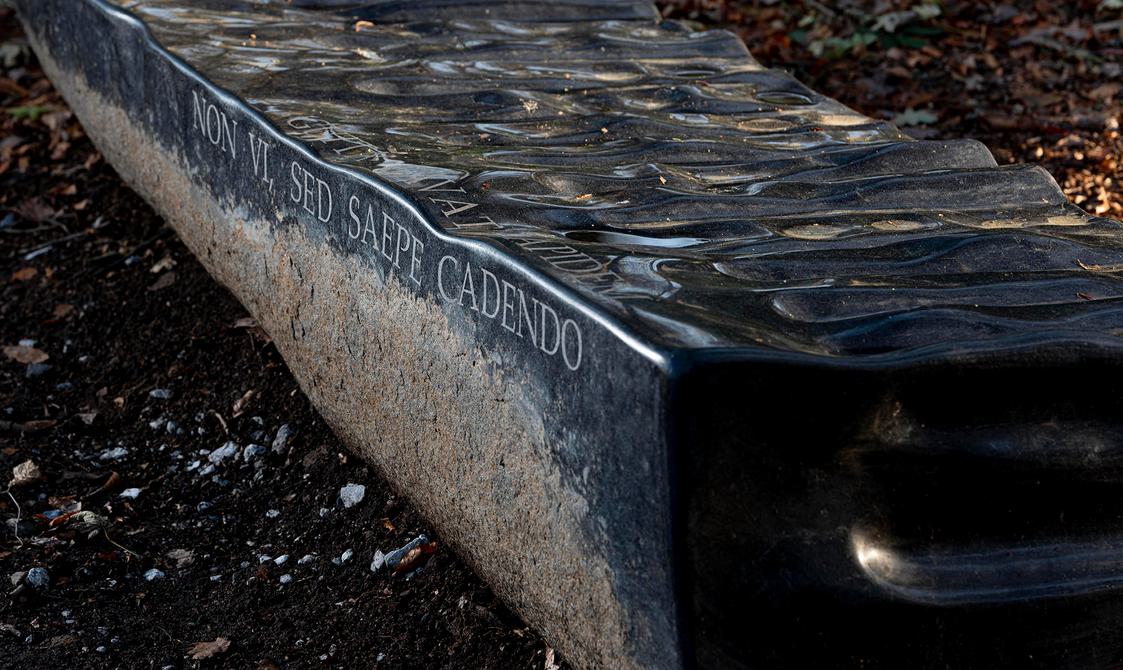
Willem Boshoff: Flagstone
Art Outdoors /Willem Boshoff: Flagstone
Willem Boshoff’s Flagstone is a sculpture and a seat, positioned here overlooking Upper Lake to provide a space for rest and contemplation. In summer 2018, Boshoff spent a month at YSP, researching and meticulously recording the flora and fauna. Each day he walked the paths around the Park and became particularly fond of the areas around the Lakes. The residency was followed by an exhibition in Upper Space and the subsequent gift of Flagstone as a permanent work for YSP’s landscape.
The black granite used for Flagstone comes from Belfast, in South Africa’s Mpumalanga province. Boshoff selected the rock from a quarry site where abandoned stones litter the landscape. The granite has a fluted surface, which gives the appearance of a fabric flag moving in the wind. The title also refers to a flat slab used for paving or as stepping stones.
The rippled surface of Flagstone also mimics the movement of water. Boshoff refers to this and contemplates the passage of time over many millennia through a Latin inscription that spills over the sculpture. The text reads: 'GUTTA CAVAT LAPIDEM, NON VI, SED SAEPE CADENDO' [a drop of water hollows a stone, not by force, but by continuously dripping]. This phrase comes from the writings of Ancient Roman poet Ovid.



Willem Boshoff (b. 1951) was born in Vanderbijlpark, South Africa. He works in a variety of media including sculpture, installation, performance and printmaking. His works reflect his interests in language and words, plants, nature, science, mathematics, astronomy, philosophy and politics.
This work is part of the YSP Collection.
You might also like
- Art Outdoors

Thomas J Price: Network
In Network, Thomas J. Price continues his exploration of identity and representation. He creates sculptures that represent people of African descent to disrupt the typified figures shown in classical Roman and Greek art, and to question who we chose to celebrate in artworks. - Art Outdoors

Heather Peak and Ivan Morison: Silence – Alone in a World of Wounds
Silence – Alone in a World of Wounds is installed alongside Upper Lake within a stand of birch trees and aims to create solitary communion with the natural world. Responding to the question 'Can art save us from extinction?', the artists developed a sculptural space made of natural materials including timber and thatch. It acts as an extended open pavilion and becomes a framework and quiet space set within nature. - Art Outdoors

Tania Kovats: RAVINE
RAVINE creates the appearance of a natural rock that has been broken apart. By using cast concrete, which has been coloured with black pigment, Kovats is further highlighting her interest in these opposing ideas. The sculpture is perfectly sited in the woodland around Upper Lake. - Art Outdoors

Idit Nathan and Helen Stratford: Further Afield
Further Afield is a series of sculptures sited around the Upper Lake for visitors to encounter and respond to. Each work is made from wooden railway sleepers, with words engraved on the surface. Certain words have been highlighted by the artists using brightly coloured paint. Over time, the wood will age and become embedded in the landscape of the Park.